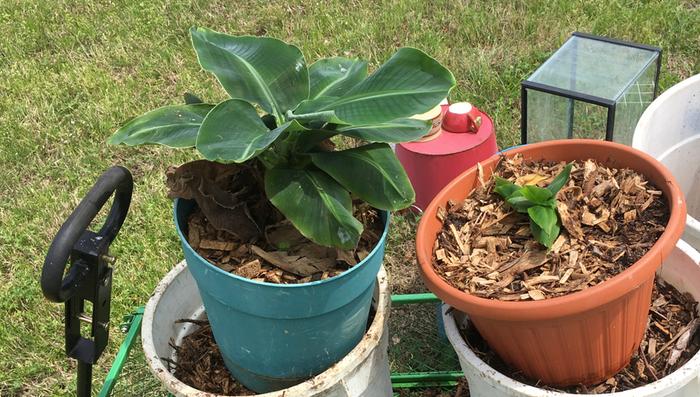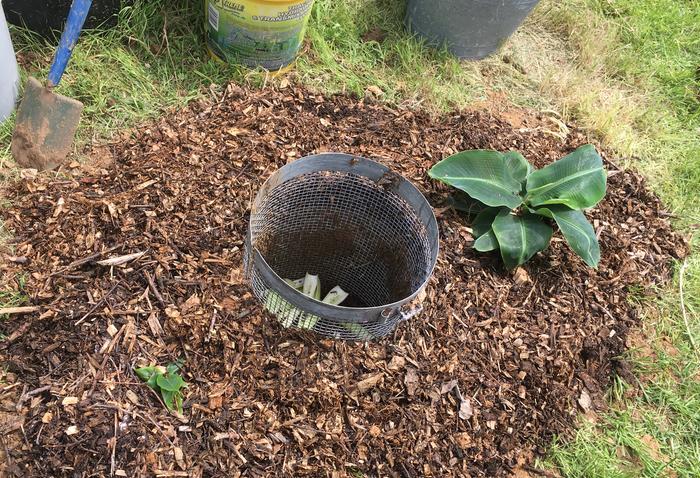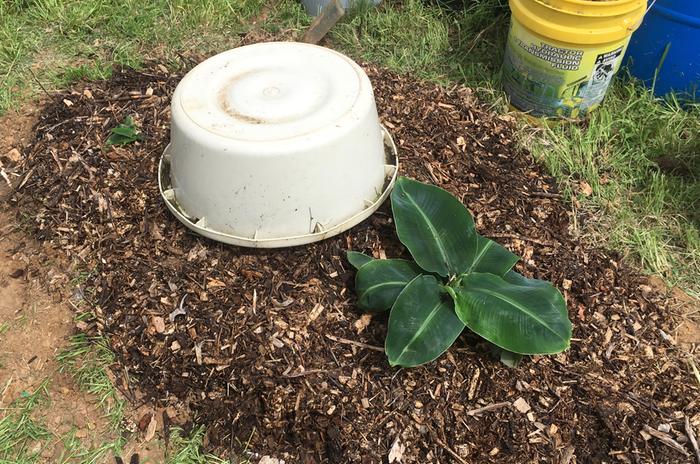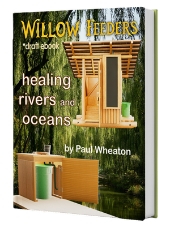
 10
10










Pecan Media: food forestry and forest garden ebooks
Now available: The Native Persimmon (centennial edition)
 2
2




 1
1




Dan Allen wrote:They dont resemble the basjoo that I grew, they look more like a cavendish type. But I am no banana expert. I did grow basjoo up north and now only grow edible varieties, and they look a lot like dwarf Cavendish, and super healthy looking.
Pecan Media: food forestry and forest garden ebooks
Now available: The Native Persimmon (centennial edition)
 1
1




 2
2




Dan Allen wrote:I think you'll have good luck either way, especially if you're in southeast oklahoma. I have read of decent results fruiting bananas there.
Pecan Media: food forestry and forest garden ebooks
Now available: The Native Persimmon (centennial edition)
 5
5




SKIP books, get 'em while they're hot!!! Skills to Inherit Property
See me in a movie building a massive wood staircase:Low Tech Lab Movie
 2
2




Mike Haasl wrote:I've had really good luck getting bananas from Florida Hill nursery. They ship well and take right off. And they're cheap. Last year I got a pair that were finger sized in diameter and 10" tall. Planted them in early July and by early September they were 8' tall with a trunk the size of my leg.
I think of them like giant hummingbirds. They looooove nirtogen. I urigated each one daily and planted them in a mix of half soil and half chicken run compost that was too hot for normal use. They loved it.
Proud member of the mad farmer liberation front.
 7
7




SKIP books, get 'em while they're hot!!! Skills to Inherit Property
See me in a movie building a massive wood staircase:Low Tech Lab Movie
 3
3




Proud member of the mad farmer liberation front.
 4
4




Dan Boone wrote:
Dan Allen wrote:I think you'll have good luck either way, especially if you're in southeast oklahoma. I have read of decent results fruiting bananas there.
That swampy little corner of the state is almost tropical, like the part of East Texas it adjoins. I'm told the Oklahoma department of fish and game is terrified that someone will introduce alligators, because they would thrive there but are not present (yet). But, sadly, no: I'm toward the middle of the state where we get hard freezes reliably every year. We even get upper-midwest style blizzards (though not as strong) once every seven or eight years. The last 4 years the low at my house has been 12 degrees F every year.
I just want a big plant with impressive tropical-looking leaves. I am not looking for fruit. However, there is a short-season banana (blue ice cream? -- it's been awhile since I did the research) that puts on fruit in 9-10 months instead of the year-plus frost-free that most bananas seem to need. We currently have a 9-month growing season, and the thirty year outlook has us shifting from 7b to a solid zone 8 as global warming continues. So it may be possible.
 3
3





 1
1




Clay Bunch wrote:
Dan thats awesome. Are you using half a minnow trap? For the inground digester? This looks like a great idea. Its like having a door for feeding your soil.
Pecan Media: food forestry and forest garden ebooks
Now available: The Native Persimmon (centennial edition)
 1
1




Kc Simmons wrote:Very cool project! Banana circles are one of the projects I haven't really considered, since I can't grow edible bananas here.
Kc Simmons wrote:So, if I understand correctly, the circles are kind of like a boggy keyhole garden, with the goals being to process organic matter, get fruit/food, then use the biomass of the plants to distribute the minerals from the compost to other gardens via mulch?
Pecan Media: food forestry and forest garden ebooks
Now available: The Native Persimmon (centennial edition)
 1
1




Pecan Media: food forestry and forest garden ebooks
Now available: The Native Persimmon (centennial edition)
 1
1




There is a narrow band along the coast of the Gulf of Mexico in which banana cultivation is possible. And it’s growing, moving northward with climate change, despite occasional havoc by arctic vortices. The Gulf South region of the US is becoming subtropical. At some point in our lifetimes, large parts of Texas, Louisiana, Mississippi, Alabama, and Georgia will experience freezing temperatures for the last time.
...
Now is probably a good time to mention that banana trees are not trees, botanically speaking. They’re the world’s largest non-woody plant, basically a big perennial grass. This is one reason why bananas are useful in this transition. Since they sprout from the root even if they’re mowed over or the aerial parts die from frost, and because each stalk dies after fruiting anyway, an arctic vortex or hurricane-force winds doesn't represent a major setback. They grow fast, able to either shade out grasses or reach tree canopy height to access sun in a forest. Ecologically speaking, we hope they will act as a mid-successional species in the transition from either temperate forest or grassland to subtropical forest.
Each stalk produces fruit after 10-15 months without a hard freeze. In other words, the narrow band on the map where it’s easy to grow bananas is accompanied by a much larger area in which they grow well but don’t fruit. This is another reason why bananas are an ideal messenger species for the coming subtropical forest; in the hills of Georgia or the Piney Woods of east Texas and western Louisiana, banana plants can thrive and multiply but don’t fruit due to freezing weather. Increasingly popular as ornamentals, their eventual fruits will bear undeniable truths about climate change.
...
Our goal is ... to produce as many human-banana-plant interactions as possible and decentralize production so that it's within everyone's reach and cannot be controlled.
As such, many of the fruit trees grown at the rural project are being sent to New Orleans to be planted along sidewalks, in lawns, churchyards, and empty lots. This effort is coordinated by Lobelia Commons, an open collective of gardeners which formed early in the pandemic. They deliver free vegetable seedlings, build micro-nursery stands to distribute free plants, help people grow edible mushrooms, and generally try to build a living food commons in the city.
Part of the joy of planting a fruit tree is knowing that the tree may outlive you, providing fruit for many generations. In New Orleans, we content ourselves with the other joy of planting a fruit tree—the part about eating and sharing the fruit during your lifetime. ... [W]e are leaving the planting of trees that only fruit after 10-15 years to our friends at higher elevations, and we are propagating banana plants, which fruit in a year or two.
Pecan Media: food forestry and forest garden ebooks
Now available: The Native Persimmon (centennial edition)




 4
4




Pecan Media: food forestry and forest garden ebooks
Now available: The Native Persimmon (centennial edition)




Dan Boone wrote:
Dan Allen wrote:I think you'll have good luck either way, especially if you're in southeast oklahoma. I have read of decent results fruiting bananas there.
That swampy little corner of the state is almost tropical, like the part of East Texas it adjoins. I'm told the Oklahoma department of fish and game is terrified that someone will introduce alligators, because they would thrive there but are not present (yet). But, sadly, no: I'm toward the middle of the state where we get hard freezes reliably every year...
...
...
American alligators are difficult to find in Oklahoma. But they can be found in remote and marshy areas in the southeastern corner of the state.
"Observe the lilies of the field, how they grow: they do not toil or spin, but I say to you that not even Solomon in all his glory was dressed like one of these."
Matthew 6:28b-29



 1
1




"Observe the lilies of the field, how they grow: they do not toil or spin, but I say to you that not even Solomon in all his glory was dressed like one of these."
Matthew 6:28b-29

|
Let me tell you a story about a man named Jed. He made this tiny ad:
Learn Permaculture through a little hard work
https://wheaton-labs.com/bootcamp
|







